On October 19th at the Mount Vernon Quad, sugar and pizza were consumed, and a good time was had!
Students made s’mores and enjoyed the fellowship of friends, make sure you come out to the next UHP event, where good times never end!
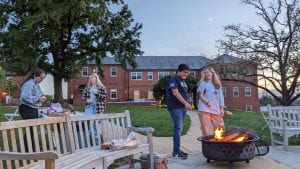
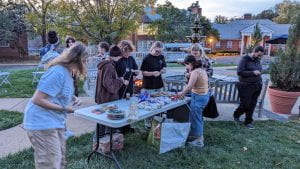
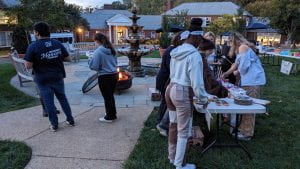
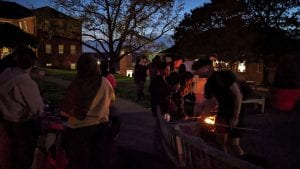
University Honors Program Blog
Intellectual Omnivores Unite
On October 19th at the Mount Vernon Quad, sugar and pizza were consumed, and a good time was had!
Students made s’mores and enjoyed the fellowship of friends, make sure you come out to the next UHP event, where good times never end!




Students from NC State University’s Honors Program visited D.C. during their Fall Break, from October 6th-9th. During their visit, they met up with students from our Honors Program to make connections, explore the city, and see GW’s campus!
On Sunday, students from both programs met in the UHP Townhouse and then walked over to the Renwick Museum to explore the galleries. The next day, the NCSU students returned to campus to meet more of our students and hear from Katie Hendrickson, the Deputy Chief of Staff at the Office of the United States Trade Representative (USTR). Students learned about the function of the USTR, working for the federal government, and were given occupational and networking advice, all while enjoying Chipotle!
Thank you to our friends over in the NCSU Honors Program – we hope to see you in D.C. again soon!
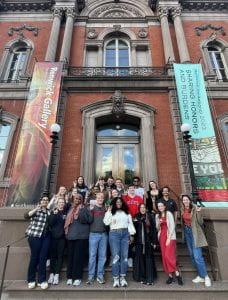


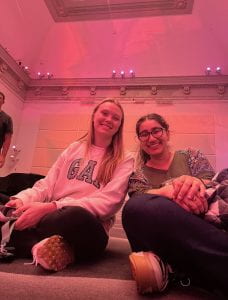
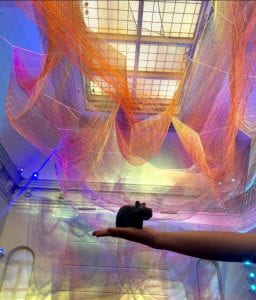
This September, seniors in the “Nature Appreciation” Capstone visited various outdoor sites around D.C., such as the U.S. Botanic Garden and the Smithsonian’s Enid A. Haupt Garden! Students were given the opportunity to appreciate the biodiversity of life found within the city, and take time to (literally) stop and smell the flowers. Be on the lookout for when Professor Moreira offers Capstone again in Fall 2024!


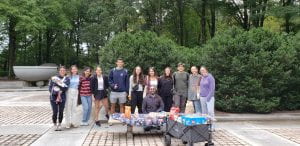

October 2nd through 6th is National Voter Education Week! GW Votes will be tabling, sharing resources, and hosting interactive activities with the GW community on getting registered, navigating mail ballots, creating a vote plan, understanding what’s on the ballot, and more!
Join us at Anniversary Park on Thursday October 5th, from 10am-3pm, or on the Mount Vernon Campus Quad on Friday October 6th, from 12:30-3:30pm!
Major issues don’t take years off. Vote in your 2023 state and local elections to make your voice heard! Statewide elections are occurring in Virginia, New Jersey, Kentucky, Louisiana, Mississippi, and Pennsylvania this November. Ohio, Texas, and Maine will also have statewide referendums on the ballot!
Get #VoteReady this week with GW Votes while enjoying free food and giveaways!
We hope to see you there, and most importantly, we hope you join us in celebrating by registering or requesting your ballot with TurboVote!
Contact gwvotes@gwu.edu with any voter questions.
Students in Professor Matthew Kirwin’s Africa Identities course took in a concert by Niger’s guitar maestro Bombino at the Hamilton Live On September 15th. The students were able to attend thanks to the “Professor on the Town” program. This initiative, which allows faculty to introduce students to events all around Washington, D.C., exposed the students to an artist who sings about the plight of the Taureg, a nomadic ethnic group that resides primarily in the Sahara region of Niger, Mali and Algeria. Bombino recently released his new album Sahel and many of his songs address the humanitarian and security challenges that the Taureg face. Bombino shared his thoughts on recent political events in Niger offering that in instances such as these the poor are the ones who suffer the most. The Bombino concert was also covered by NPR’s Leila Fadel on Morning Edition. Senior Honors Program student Lucas Souza remarked that “Bombino’s music was a great opportunity to take a trip somewhere very far from Foggy Bottom.”
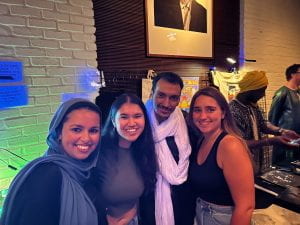
Once again, UHP students demonstrated their skill in cunning in successfully escaping from “The Submarine” and the “Western Bank Heist” in under 60 minutes! If you’re a rising senior who loves games, look for this Capstone option which will be available again in Fall 2024.
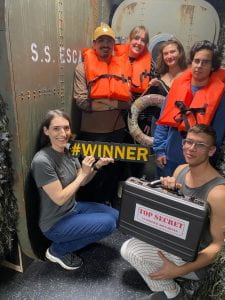
Do you have any ideas or suggestions about the Honors Program that you’d like us to hear? Do you have any questions? Whether you’re a first-year student or nearing graduation, come join the UHP Director, Professor Kung, for a “Breakfast with the Director” event on Friday, September 22nd at 11 am in the Foggy Bottom townhouse Club Room. Please RSVP with the form below:
The following blog post was written by fellow UHPer and Spring 2023 SURE Award recipient, Peri Wivell (Biology -Cellular and Molecular concentration Major, ’23). Read on about how Peri plans to utilize the SURE Award funding to further expand upon her research experience!
Getting involved in research has always been a top priority for me throughout my undergraduate experience. I joined Dr. Maho Shibata’s lab in the GW Cancer Center during my sophomore year. Our lab applies concepts from developmental biology and stem cell biology to prostate cancer research. We use genetically engineered mouse models, explant cultures, and 3D organoid culture systems to study androgen signaling during prostate development, and to identify novel molecular drivers of castration-resistant prostate cancer. Under the mentorship of Dr. Shibata and her team, I learned several techniques essential to conducting effective research and started working on my own research project in spring of 2021.
My research involves studying the role of macrophage populations during development and in diseases of the prostate. Macrophages are specialized cells involved in a host of immune functions and have been known to play an important role in both pro- and anti- inflammatory responses. Benign Prostatic Hyperplasia (BPH) is a common diagnosis affecting the aging male population with increasing prevalence and although the disease has become progressively common, its cause and mechanism of progression remain poorly understood. Because BPH is a disorder influenced by inflammation and the origin of macrophages in the prostate has not been fully elucidated, understanding the recruitment of macrophage populations could lead to the development of more effective treatments and therapies than those which currently exist.
Over this past summer and academic school year, I have been designing experiments, dissecting and embedding samples, conducting immunohistochemical and immunofluorescence staining on tissue sections to get a better understanding of the role these cells play on a microscopic level. In addition to gaining experience in conducting laboratory research and working with genetic model organisms, I’ve also improved my scientific communication and writing skills. This past summer, I presented my findings on the involvement of macrophages in different mouse models of prostatic diseases at the Summer Program Advancing Research on Cancer (SPARC) poster session. It was a wonderful opportunity for me to share my research with, while simultaneously learning from, other students and faculty working in different areas of cancer biology.
Because my research project requires daily/multi-day time-sensitive experiments, this makes summer an ideal time to make significant progress as I am able to work in the lab full time. With the support of the SURE award, I will continue to work on my project and use my findings to complete my senior thesis. Working in Dr. Shibata’s lab has been an invaluable part of my undergraduate experience and has not only helped me in my academic pursuits, but has also contributed significantly to my preparation for fulfilling my professional goals. I am hopeful that our research will lead to the development of more effective methods to prevent, detect, diagnose and treat cancer along with other diseases.
Interested in applying for your own SURE Award funding? Find out more about the application process here!


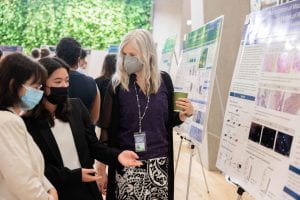
The following blog post was written by fellow UHPer and Spring 2023 SURE Award recipient, Anuka Upadhye (International Affairs Major, ’23). Read on about how Anuka utilized the SURE Award funding to further expand upon her research experience!
I used my SURE Award to attend the UN Water Conference from March 22nd to 24th at the UN Headquarters in New York City. As someone who is interested in international environmental issues, specifically water justice and climate change, I was really excited that the UN was hosting its second water conference after 46 years. Thanks to the GW Sustainability Department, a cohort of GW students and faculty were able to attend. Some of the highlights were being able to sit in the General Assembly hall and observe a plenary session, where representatives of member states discussed the future of water security in their respective countries and made voluntary commitments to help other countries finance water projects. This conference was the first time I witnessed international climate change policy in action, and helped me understand how the UN worked. It was also amazing to see so many people who are interested in global water issues under the same roof, and I felt united being near people that understood the stakes of climate change and water. Unfortunately, I left the conference with mixed opinions. Many of the events over-represented global north countries, excluded the voices of marginalized groups, and lacked tangible results. However, I am grateful for the SURE Award and the UHP for giving me the opportunity to step foot in the UN Headquarters and get an inside look on what actually happens behind closed doors. Going to the conference has allowed me to be a more coherent critic of the UN’s current shortcomings, and actively channel the frustrations I felt during the conference into ways to address current gaps in the field. Overall, getting this experience has solidified that I would like to work on climate change and water justice throughout my career because of the urgency to solve these global issues. Without the SURE Award, I would not have found this clarity. Thanks again!
Interested in applying for your own SURE Award funding? Find out more about the application process here!
The following blog post was written by fellow UHPer and Spring 2023 SURE Award recipient, Sana Hafiz (Public Health Major, ’24). Read on about how Sana plans to utilize the SURE Award funding to further expand upon her research experience!
The research I have been participating in this semester is in Dr. Shooks Biochemistry and Molecular Medicine Lab. This lab focuses on the tissue damage that occurs due to inflammation and injury to the skin. By researching the cell variants that are responsible for this process, pharmaceutical advancements are being made. For example, fibroblasts play a critical role in numerous physiological processes, including wound healing, tissue repair, and immune response. The research am conducting this semester aims to understand the molecular mechanisms underlying fibroblast function which is crucial for developing treatments for various related skin, immune diseases, and conditions. My research’s area of interest is the expression of inducible nitric oxide synthase (iNOS) in fibroblasts, and its role in cellular functions. iNOS takes part in a crucial role in the inflammatory response, therefore, the expression of iNOS and its role in cellular functions are areas of active research, and a better understanding of its regulation and function is crucial for developing treatments for various diseases and conditions.
The goal of this project is to investigate the expression patterns and subcellular localization of iNOS in fibroblasts using Immunofluorescence Antibody Staining. This will provide insight into the role of iNOS in fibroblasts, and its impact on cellular functions such as proliferation, migration, and differentiation. The results of this study will advance our understanding of fibroblast biology, and provide a foundation for future research in this field.
The implications of the research related to skin wound healing are very high, such as using our research in a pharmaceutical means, making each step of the research process very rewarding, even when things feel tedious. Applying my academic knowledge from my classes to research and vice versa also keeps me interested and motivated in my research.
The SURE Award was used to purchase antibodies used in immunofluorescence staining to observe where fibroblasts express iNOS proteins in the skin adjacent to wounds.
The next step of this research is to analyze the stained slides so that we can provide an analysis of iNOS in fibroblasts and its impact on cellular functions. Once completed, the findings of this study will provide a foundation for further investigations into the mechanisms underlying iNOS expression in fibroblasts and its implications in various physiological and pathological conditions.
Interested in applying for your own SURE Award funding? Find out more about the application process here!